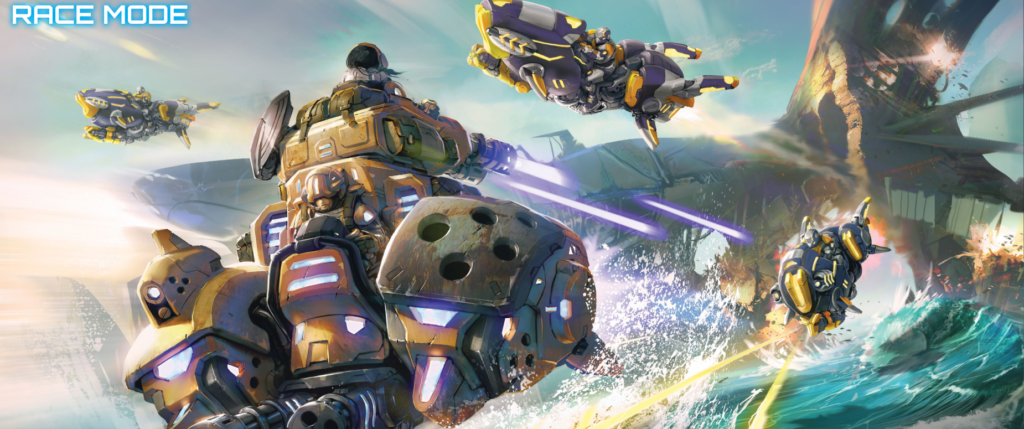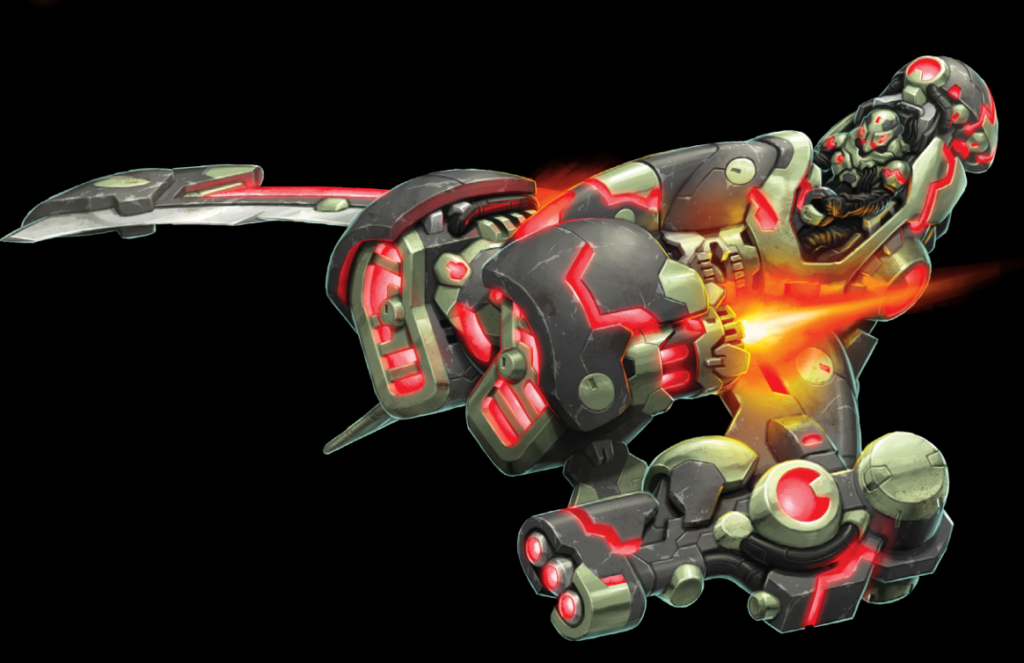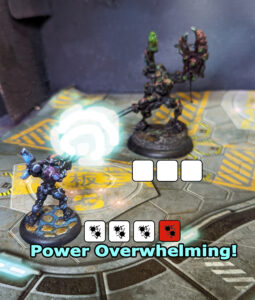I wrote this article to help you play a bloody quick game of Warcaster that lets you rip through Primary games at light speed.
Firstly – Why can Warcaster be slow?
In other tabletop games you start with your complete army and every round your options diminish as models are removed from the game.
In Warcaster your options expand every turn as you make decisions about what to deploy, and where to place future gates.
This article is not aimed at new players
Before we get too deep into this let’s make one thing clear – most of the things that speed up the game come with familiarity. As a new player, no one expects this of you. Take longer, learn your models, and have fun. Worrying about getting your games to be quicker can come later.
How do we fix this?
We need to have a plan before we walk into a game.
Executing a plan is fast.
Warcaster allows you to tinker, create and adjust a plan on the fly which bogs your turns down.
What tools can we use to create a plan we can execute?
- Know your models rules
- Have a clear reason for including a model
- Have a clear reason for including a cypher
- Have standard plays
- Have standard gate deployments
- Be Okay with misplays
- Practice with a clock

1. KNOW YOUR MODELS RULES
There’s a lot of time to be saved by never having to look up the statlines of your models. A few tips I have here is:
- Start by learning the stats of the models you use the most.
- Look for patterns that make model statlines easier to remember.
- For example I play AC, and one of the first models I ever used is the Marauder solo who is DEF 2, ARM 4. Raxis and Synturions have an identical statline, so i just call them “Marauder Equivalents” in my head.
- Another good pattern to learn is when the MAT/RAT and POW of the weapon is identical. There is a decent number of these out there!
2. HAVE A CLEAR REASON FOR INCLUDING A MODEL
Identifying what role your model plays, and therefore why you bring it lets you act quick.
I’ll apply this to AC:
My main models for killing enemy models:
- Nemesis (heavy warjack)
- Scourge (light warjack)
- Divine Tempest (Combat solo)
- Axel for hire (Combat solo)
- Phatheon, Whisper of Death (Combat solo)
My main models for contesting objectives:
- Nekosphinx
- Marauders (created from DT gun)
- Scythe (usually as part of a scything run)
My main models for holding and scoring objectives:
- Synturions
- Talons
These roles don’t mean my scorers can’t kill, or that killers can’t hold objectives. Shorthand lets you act rather than think.
In action – An opponent is controlling an objective on end of pulse round scoring with a squad, and there’s another objective they are likely to move models on before end of pulse round. I can drop a gate prepared to bring out a pair of Nekopshinxes who each can walk and place in contesting range. I can make this decision quickly because I know which models I brought for this job.
3. HAVE A CLEAR REASON FOR INCLUDING A CYPHER
When including a card in your deck, knowing why you included it is key. For example, Displacement Index:
I use displacement index to move squads out of activation on to points to score. Squad activations in my lists tend to be worse than my other activations. In a primary game you only get 15 chances to activate a squad, heavy or vehicle. In a skirmish you get 9.
Therefore – displacement index saves a boring, but necessary movement, and allows you to simultaneously make a tempo play.
Is it possible for me to use displacement index to help my models move across the board? Absolutely, but it’s not in my plan and It’s not usually worth thinking about.
4. HAVE STANDARD PLAYS
Let’s talk about the primary mission Orders of Magnitude to demonstrate my plan. I know that I want to summon squads, place squads onto objectives, and either contest my opponent’s objectives, kill their scoring models, or do both at the same time.
So I’ll have a checklist for deployment. For me, that’s check if I have arcane synthesis, and if I do I’ll bring out a Nemesis and a Nekosphynx. Both can move very quickly, and the Nemesis can kill scoring models while it moves onto objectives. My Nekosphynx guarantees I have a gate wherever I want on turn 1 and turn 2.
Then I have a rough plan of things I want to do. I’ll list some:
- Summon squads from gates within 3” of an objective so I can use a cypher to move them out of activation to score (landing all models on the objective)
- Summon Nekosphyxes within 15” of enemy objectives so I can walk and place on to them and force the enemy to deal with def 4 and 3hp before they can score
- Summon a Scythe within 12-15” of enemy objectives so I can do a scything run and a couple of strafe shots on the way in to contest
- Use a divine tempest to kill models off an objective, ideally while creating marauders or phatheon with its gun to contest other objectives
- Apply fire to enemy models I expect to stick around a long time with my cypher when I have it in hand (e.g. Heavies)
- Potentially summon a full talon boat (Talons + Relikon) and Divine Tempest from a 5-gate in an area I want to control.
As the game goes on, I’ll commit to doing these as I get the opportunities.

5. HAVE STANDARD GATE DEPLOYMENTS
I like to have a few planned gate deployments that I can fall back on.
Let’s talk about three 5 arc gates I can summon using Talons:
- Talons + Relikon + Divine Tempest
- Talons + Relikon + Scourge
- Talons + Relikon + Tulcan + Raxis
I have a good feeling for when and where I’d like to place these. For example, the Tulcan + Raxis gate is a common early game gate for me in an area I feel confident I control, where I don’t need to kill enemy models. This gives me support benefits from my solo abilities.
I’m going to bring in a Divine Tempest when there’s killing to be done. However – if I’m holding recurrent apotheosis in hand that means I don’t need to pay for my Divine Tempest, which is where the scourge gate comes in.
I have a few gates I’ll use explicitly for contesting enemy objectives:
A 2-3 arc gate that’s main goal is to bring out nekosphynxes, or a 3-4 gate that I use to bring out a scythe (and maybe a nekosphynx too!)
I won’t place down a 4 arc gate for a Nemesis unless I also have Arcane Synthesis in hand.
6. BE OKAY WITH MISPLAYS
The game is so fluid with so many decisions tugging you every different direction that it helps me before a game to remember that I am not going to play perfectly, or even well, and that there’s no real stakes so why slow a game down trying to find the absolute perfect move when I could take an adequate move and learn from my mistakes later?
7. PRACTICE WITH A CLOCK
Practicing with a clock can increase your awareness of how much time you are spending making decisions. You don’t have to play to the clock, there can be zero interaction with the gameplay.
Simply use it as a tool for practicing getting your average turn time down, and for cutting your decision making down.
A full primary game of warcaster can be completed in 2 hours if both players average 4 minutes a turn. In fact, every additional minute that both players average increases the game’s total length by half an hour.
TL:DR
You need to walk in with a plan instead of trying to evaluate a myriad of options on the board, and focus on executing templated actions you’ve thought about ahead of time, and turned into muscle memory.
As you play more games you’ll refine this muscle memory.

Solid advice! Nicely written!